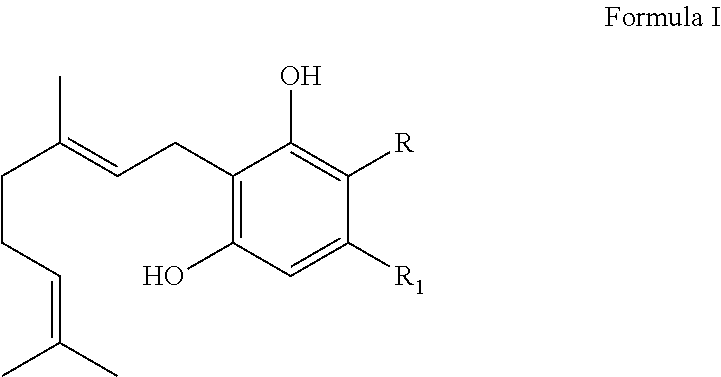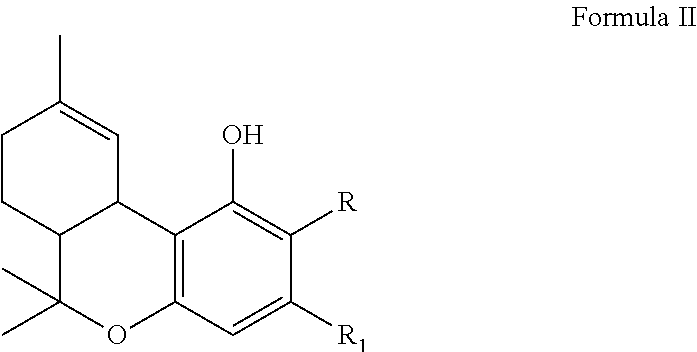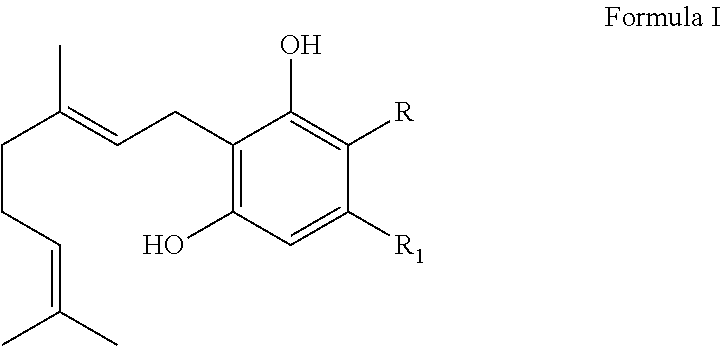BIOENZYMATIC SYNTHESIS OF THC-v, CBV AND CBN AND THEIR USE AS THERAPEUTIC AGENTS
a bioenzymatic and cannabinoid technology, applied in the field of biosynthesis of cannabinoids, can solve the problems of slow acceptance of phytocannabinoids as candidate therapeutic agents for treating such disease conditions, and not much is known about the biosynthesis of these cannabinoids or why
- Summary
- Abstract
- Description
- Claims
- Application Information
AI Technical Summary
Benefits of technology
Problems solved by technology
Method used
Image
Examples
example 1
of Olivetol
[0122]
[0123]Olivetol was synthesized using a published procedure (Focella, A, et al., J. Org. Chem., Vol. 42, No. 21, (1977), p. 3456-3457).
A. Methyl 6-N-Pentyl-2-hydroxy-4-oxo-cyclohex-2-ene-1-carboxylate
[0124]
[0125]To a stirring solution of sodium methoxide (32.4 g, 0.60 mol) and dimethyl malonate (90 g, 0.68 mol) in 230 mL of anhydrous methanol was added portion wise 75 g (0.48 mol) of 90% 3-nonen-2-one. The reaction mixture was then refluxed for 3 h under N2 and allowed to cool to room temperature. The solvent was distilled under reduced pressure and the residue dissolved in 350 mL of water. The slurry of white crystals and the almost clear solution was extracted thrice with 80 mL of chloroform. The aqueous layer was acidified to pH 4 with concentrated HCl and the white precipitate that formed was allowed to stand overnight prior to filtration. The crystals were dried at 50° C. under high vacuum for 5 hours to yield 106.5 g (0.4416 mol) (92%) of methyl 6-n-Pentyl-2-hy...
example 2
of 2-[(2E)-3,7-dimethylocta-2,6-dienyl]-5-pentyl-benzene-1,3-diol (Cannabigerol (CBG)
[0130]CBG was synthesized following the protocol disclosed by Taura et al., (1996), The Journal of Biological Chemistry, Vol. 271, No. 21, p. 17411-17416.
[0131]Geraniol (3 g, 0.0194 mol) and olivetol (2 g, 0.0111 mol) were dissolved in 400 mL of chloroform containing 80 mg of p-toluenesulfonic acid as catalyst and the reaction mixture was stirred at room temperature for 12 h in the dark. After 12 hours, the reaction mixture was washed with saturated sodium bicarbonate (400 mL) and then with H2O (400 mL). The chloroform layer was concentrated at 40° C. under reduced pressure, and the residue obtained was chromatographed on a 2.0 cm×25 cm silica gel column using benzene (1000 mL) as the eluent to give 1.4 g (0.00442 mol) (39.9%) CBG as product.
[0132]Alternatively crude CBG was purified as follows. To a 250 mL beaker was added 7.25 g crude CBG and 50 mL benzene. The flask was swirled to dissolve the CB...
example 3
of Methylmagnesium Carbonate (MMC)
[0134]Methylmagnesium carbonate (MMC) was synthesized following the protocol disclosed by Balasubrahmanyam et al., (1973), Organic Synthesis, Collective Volume V, John Wiley & Sons, Inc., p. 439-444.
[0135]A dry 2 L, three necked flask was fitted with a mechanical stirrer, a condenser, and a IL, pressure-equalizing addition funnel, the top of which was fitted with a gas inlet tube. A clean, dry magnesium ribbon (40.0 g, 1.65 mol) was placed in the flask and the system was flushed with nitrogen prior to the addition of anhydrous methanol (600 mL). The evolution of hydrogen gas was controlled by cooling the reaction mixture. When hydrogen evolution had ceased, a slow stream of nitrogen was passed through the system and the condenser was replaced by a total condensation-partial take-off distillation head. The nitrogen flow was stopped and the bulk of the methanol distilled from the solution under reduced pressure. Distillation was stopped when stirring ...
PUM
 Login to View More
Login to View More Abstract
Description
Claims
Application Information
 Login to View More
Login to View More - R&D
- Intellectual Property
- Life Sciences
- Materials
- Tech Scout
- Unparalleled Data Quality
- Higher Quality Content
- 60% Fewer Hallucinations
Browse by: Latest US Patents, China's latest patents, Technical Efficacy Thesaurus, Application Domain, Technology Topic, Popular Technical Reports.
© 2025 PatSnap. All rights reserved.Legal|Privacy policy|Modern Slavery Act Transparency Statement|Sitemap|About US| Contact US: help@patsnap.com



